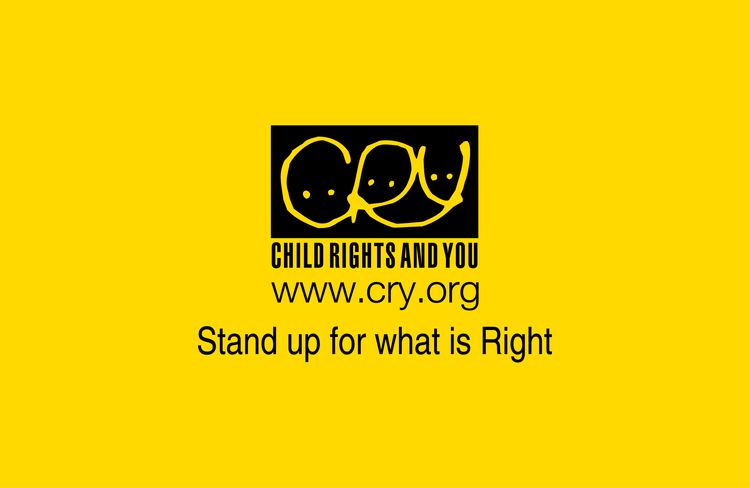Type Community Service Method Partnership with NGOs Revenue ~Rs.36 crores Founded 1979 | Focus Children's Rights Key people Raijain Mandarica Founder Rippan Kapoor Number of employees 150 | |
 | ||
Motto Stand up for what is right Similar Profiles | ||
Child Rights and You commonly abbreviated as CRY is a non-profit organisation working in India, which aims to restore children's rights. The organisation was established in 1979. The organisation partners with grass-roots Non-governmental organisations to uplift thousands of Indian children denied basic children's rights. It works towards restoring basic rights to children, especially from India and works across levels from direct action to advocacy, mobilizing public opinion and policy change.
Contents
It was started by Rippan Kapur in 1979 with Rs 51 , he died in 1994 at the age of 40. However, by then, the organisation has grown, in 1993 the organisation had spent Rs.1.75 crore on 58 projects in rural, urban and tribal areas.
It focuses mainly on the 4 basic rights of survival, development, protection and participation which were defined by the United Nations Convention on the Rights of the Child (CRC), an international human rights treaty which has been ratified by 192 countries.
Basic principles(Children's Rights)
The CRC is built on certain "foundation principles" that underpin all other children's rights. The CRC confers the following basic rights on all children across the world, without discrimination
CRY works to ensure these rights to all categories of children, who could be street children, children bonded in labor, children of commercial sex workers, physically and mentally challenged children and children in juvenile institutions, or even children in privileged homes A
History
In 1979, seven friends made a simple decision to change the lives of India's underprivileged children. Led by a 25-year airline purser, Rippan Kapur, Rs. 50 and a dining table as their resources and a belief that each one can make a difference in a child's life, they aimed to enable all children to realize their full potential. This was how CRY began.
The founders of CRY chose not to fund a grassroots-level implementing organisation working directly with and for underprivileged children. Instead, they opted to make CRY a channel or a link between the millions of individuals who could provide resources and the thousand of dedicated fieldworkers who were struggling to function for lack of them.
In 2007, its media campaign showing "smiling kids" and asking citizens to partner instead of simple donate, was seen as departure from stereotypical NGO sector advertising in India
Financial information
Tha primary source of revenue for the charity is through donations by individuals and organisations. In the financial year 2004-05, its income through donations, sale of products and interest was around Rs.45 crores[1]. Around Rs.14 crores was used for mobilising income, Rs.2.3 crores was incurred for establishment and other expenditure and around 17 crores were disbursed to over 120 organisations throughout the country.
Mission
To enable people to take responsibility for the situation of the deprived Indian child and so motivate them to confront the situation through collective action thereby giving the child and themselves an opportunity to realise their full potential.
To work in partnership with individuals and organisations, and support them financially / non-financially as well as with people from all walks of life, who believe in the rights of children. Within CRY too, each function works in unison towards ensuring the vision of equal rights for all children.
Areas of work
The key functions of Development Support (grant making) and Resource Mobilisation (fundraising) along with the other support functions - Communications, Human Resources, Youth and Volunteer action, Finance, Planning and Information Technology, Policy and Research, Documentation, The CRY Shop - all play a critical role in the organisation building efforts.
It works towards restoring basic rights to children, especially from India and works across levels from direct action to advocacy, mobilizing public opinion and policy change. It focuses mainly on the four basic rights of survival, development, protection and participation which were defined by the United Nations Convention on the Rights of the Child.
The CRC is built on certain "foundation principles" that underpin all other children's rights.
CRY’s approach works through a three-phase engagement: • First, CRY chooses to work in areas where the human development indicators are the worst in the country – seeking out the most marginalised communities and their children. It examines the situation of the children in these communities in a holistic manner, covering the entire gamut of issues that affect them. • CRY then seeks to understand the root causes of the deprivation faced by children in education. In India, the root causes that prevent children from accessing their rights often tend to be: i) gender- or caste-based discrimination in the home, the community or in school, ii) the lack of adequate livelihoods for the adults, forcing them to make their children work as child labourers, or iii) forced displacement that forces families to migrate, and also pushes children to drop out of school. Finally, CRY and its partners mobilize the local community to find long-term solutions to these root causes by making sure that the laws and policies that guarantee their rights are actually implemented. CRY started work on empowering under-privileged children and the communities they belonged to by actively partnering smaller / grassroots-level NGOs working in remote and neglected areas of India. These smaller organisations are trained to mobilise rural and urban communities to access their entitlements through collective action.
The process of building the community-based collectives entail educating and informing the rural poor about their entitlements to education as given by the Government under the relevant Acts and Schemes; and enabling them to demand these entitlements from the local government.
